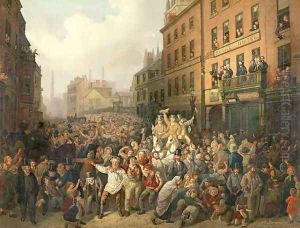Vladimir Ossipovitch Sherwood Paintings
Vladimir Ossipovitch Sherwood, also known as Vladimir Osipovich Sherwood, was a prominent Russian architect born on August 17, 1832, in the town of Bratolyubovo, Russia. His father was an English engineer who had settled in Russia, and his mother was Russian. Growing up in a bicultural environment, Sherwood was influenced by both Western and Russian cultural traditions, which later reflected in his architectural works.
Sherwood was educated at the Moscow School of Painting, Sculpture and Architecture and the Imperial Academy of Arts in St. Petersburg. After finishing his studies, he returned to Moscow, where he spent the majority of his career. He was part of a generation of architects who were pivotal in shaping the Russian capital's appearance during the second half of the 19th century.
One of Sherwood's most significant works is the State Historical Museum, located between Red Square and Manege Square in Moscow. Constructed between 1875 and 1881 to commemorate national history, the museum is a key example of Russian Revivalist architecture, a style Sherwood was particularly known for. This style sought to combine traditional Russian architectural forms with the technical advances of the time.
Sherwood also contributed to the design of other important buildings in Moscow, including the Russian State Library, then known as the Rumyantsev Museum. His works are characterized by their intricate detailing, use of traditional Russian motifs, and a strong sense of national identity. Beyond public and cultural buildings, he also designed private residences and urban plans, leaving a lasting impact on the architectural fabric of Moscow.
Vladimir Ossipovitch Sherwood passed away on July 19, 1897, in Moscow. His legacy continued through his son, Vladimir Vladimirovich Sherwood, who also became a notable architect. Together, the Sherwoods played a vital role in shaping the historic architectural landscape of Moscow, bridging the gap between Russian tradition and modernity.
